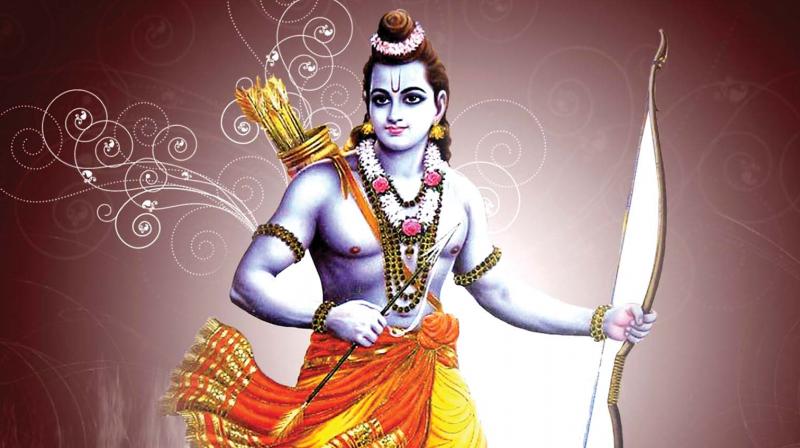The battle for Sri Rama
The Left was indeed forced into viewing them from a different perspective, and political exigency is one reason.

The slugfest in Kerala between the political Right and the Left over the observance of the Ramayana month is turning out to be a battle for the legacy of Rama with both accusing the other of an attempt to appropriate the epic hero for political purposes.
Admittedly, the orchestrated campaign to convert Karkidakam into a period for reading of the Ramayana was the result of a move started in the beginning of the 1980s by the organised Hindu Right.
At that time, Leftist intellectuals had tried to debunk the attempt stating that it was revanchist and an effort to take Kerala backwards in time. Left-leaning organisations like the Purogmana Kala Sahitya Sangham were in the forefront of this move, drawing pointed attention to episodes in the classic like the killing of Shambuka, an outcaste, by Rama for having dared to do penance.
Nevertheless, as the collective reading of Ramayana has attained popularity almost all over Kerala now, Leftist intelligentsia has become more concerned with what they believe to be the “aggressive/ masculine” depiction of Rama in public consciousness. The motif of Rama now being projected is of a hero, ready with bow and arrows to do battle, not the other redeeming features traditionally associated with the classic, like compassion, piety and kinship.
Indeed, the Ramayana has had many variants but Valmiki’s work has by now become the most widely accepted one. Scholars like A.K. Ramanujan have written about its different “tellings” spread as far afield as Japan and for not less than 2500 years.
One of the manifest dilemmas of the Left in Kerala has been whether to negate the mainstream religious legacy of the Ramayana altogether or to engage with it, almost from the “inside”, to amplify its diverse strands. Is the Ramayana sacred or secular? Is Rama the epitome of Godhead or a character in theatre? Is the literary classic a divine compass for our daily lives or a compilation that reflected a period in time?
In a sense, the move by organisations like the Samskrita Sangham in arranging Ramayana lectures this month is a continued demonstration of this problem. Having dubbed Hindu reform movements as not conforming to classical Marxian models of evolution, the Left finds itself clueless even as a triumphalist Right increasingly succeeds in fostering a unitary account of our epics.
To be sure, there have been different approaches to the story of Rama in different times and climes. For instance, the much-vaunted incident of the squirrel aiding the construction of the bridge across the seas is nowhere in Valmiki Ramayana. It is also clear that the versions of the epic, spread as far afield as Indonesia and Japan, have their own diversities.
Further, there are narrations in Valmiki’s text itself which point to the frailties of the drama’s hero and humanise him like in any other play. Soon after the slaying of Ravana, when everyone would expect a happy reunion, there is the tragic scene of the repudiation of Sita by Rama, who says that “There is a stain on your character... What man of spirit and born in a noble family for his part would take back with an eager mind a woman who has dwelt in another’s house? Therefore, go wherever you like, O Janaka’s daughter”. (Valmiki Ramayana Gita Press Page 642)
In the words of V.S. Srinivasa Sastri -- freedom fighter and acclaimed as the silver-tongued orator of the British Empire -- “Sri Rama was just a human being and when he was angry he said foolish things. When he was sorry, he wept bitter tears” (Lectures on Ramayana: Rt. Hon. V.S. Srinivasa Sastri Page 171).
Obviously, critiques of both the Ramayana as a story and Sri Rama as a “character” are from within the traditions – which uphold the religious sentiment with which millions adore the Ramayana and consider Sri Rama to be God’s incarnation. There is no denying that it is our national epic and part of our proud legacy.
It is also worth noticing that even the Dravidian/rationalist movement in Tamil Nadu has not been able to shake off Ramayana’s religious influence.
It is this distinction of how central the Ramayana and Sri Rama are to Indian ethos that the Left needs to absorb if it is to posit a durable response to Rightist deviations from our essentially centrist/catholic traditions.
The Left intelligentsia has largely missed this vital aspect and continued to view the practices and traditions of the Hindu fold from outside through the prism of historical materialism.
For instance, In his work titled “A history of the Indian freedom struggle”, even a respected Marxian thinker like the late E.M.S Namboodiripad categorises the reform movements like those of Raja Ram Mohan Roy in Bengal, Jyotibha Phule of Maharashtra and Sri Narayana Guru in Kerala under a Chapter titled “Hindu revivalism: The ugly face of nationalism”. In this critique, EMS dubs the Ramakrishna-Vivekan anda movement, the Theo sophical Society and the activities of Lokamanaya Tilak and Bankim Chandra Chatterjee as essential products of Hindu revivalism, which represented the “inherent weakness of bourgeois nationalism”.
It is another matter that all those categorised by EMS as Hindu revivalists like Sri Narayana Guru and Swami Vivekananda have had to be later co-opted by the Left!
The problem for the current crop of Left scholars like Sunil P. Ilayidom -- arguably the most coherent proponent of Marxian interpretations of Indian culture and traditions – is whether to remain on this tack of seeing the celebration of Ramayana Masam as the continuation of what EMS called the “ugly face” of nationalism/ revivalism or to construct a different narrative which will strike a chord and find resonance with even the faithful “inside” the fold.
(The writer is a banker. Views are personal)

